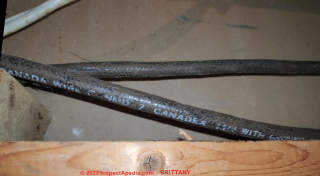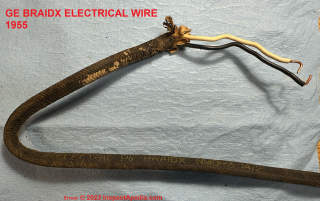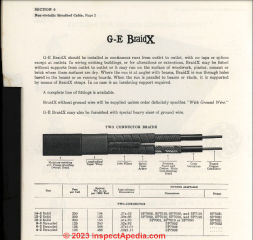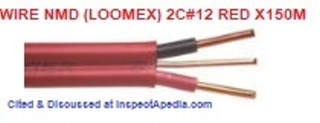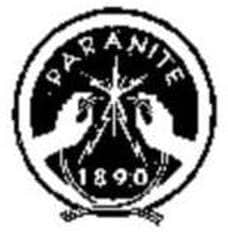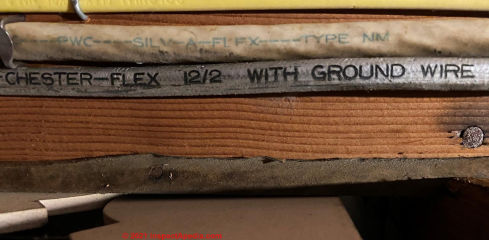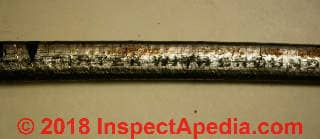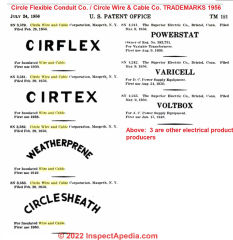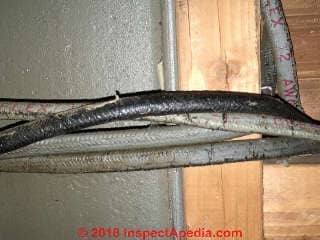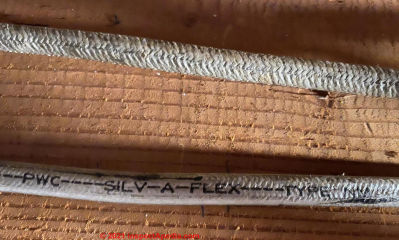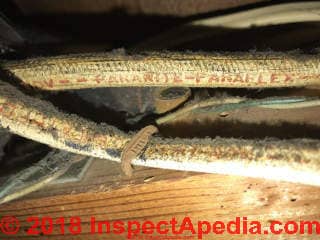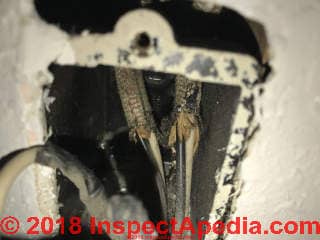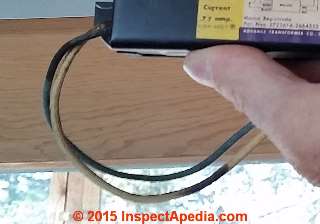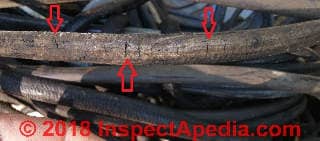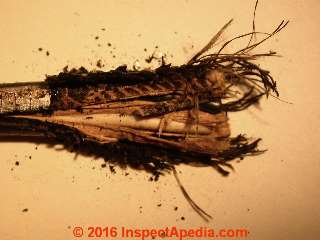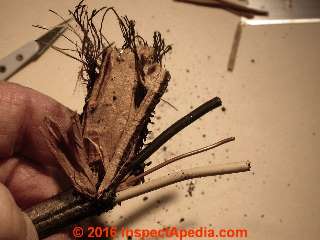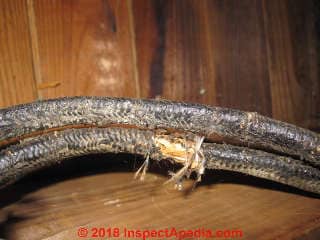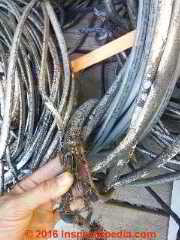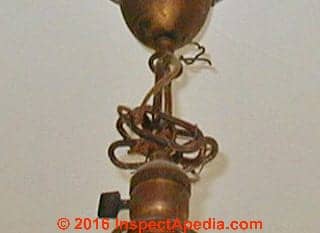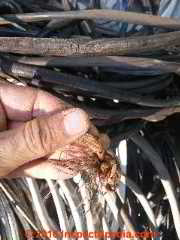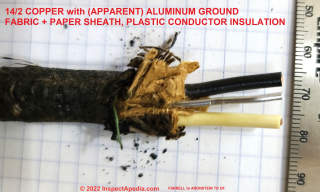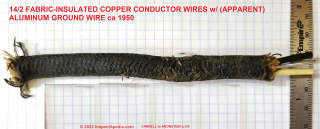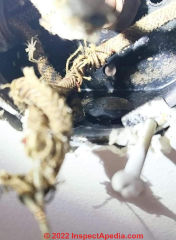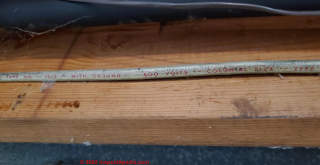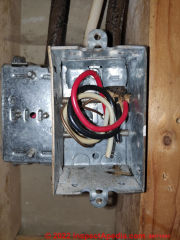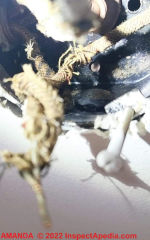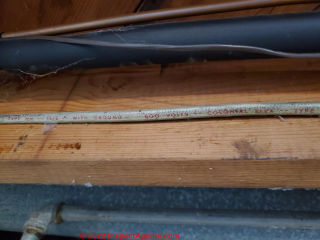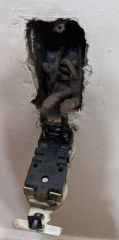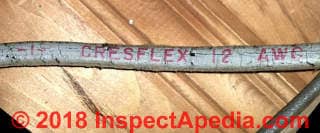 Old Fabric-Insulated Electrical Wire & Cable Identification
Old Fabric-Insulated Electrical Wire & Cable Identification
Photos, history, safety, trademarks, properties
- POST a QUESTION or COMMENT about old house wiring, knob & tube, old fuse panels, old house wiring condition & safety
This article provides a photo-guide to identification of older fabric-insulated electrical wire manufacturers and include trademarks, and identification details for these cloth-insulated wire types.
We include old electrical wire safety advice and describe frayed, or damaged cloth/fabric insulated wiring. In good condition such wiring may be safe but if cracked, frayed, or previously overheated, the wire may need to be replaced.
InspectAPedia tolerates no conflicts of interest. We have no relationship with advertisers, products, or services discussed at this website.
- Daniel Friedman, Publisher/Editor/Author - See WHO ARE WE?
Photo Guide to Black, Gray, Orange, Silver & White Colored Fabric Covered NMC Electrical Wire Insulation
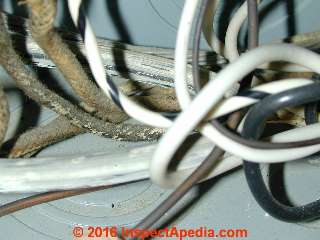 Fabric-sheathed electrical wire was popular in North America from 1950 to the mid 1970s when it began to be replaced in most new work by plastic-sheathed wire.
Fabric-sheathed electrical wire was popular in North America from 1950 to the mid 1970s when it began to be replaced in most new work by plastic-sheathed wire.
The exterior insulation on fabric-insulated NMC electrical wires are often black, silver, or white but may also be black or brown.
The individual conductors within the cable may be insulated in rubber or fabric-covered rubber or they may be insulated by plastic in later wiring products.
[Click to enlarge any image]
Where fabric insulated or fabric-sheathed electrical wire is found in buildings you should examine its condition for evidence of damage or deterioration such as frayed insulation or crumbling rubber conductor insulation.
Those conditions are most-likely to be found in electrical boxes and devices, though on occasion we also find wire that has been damaged by water leaks, weather exposure, and even rodents. Of particular concern is any electrical wire that has become fragile, cracked, fraying due to overheating or other site conditions.
Watch out: Damaged electrical wire of any type - fabric or plastic or armored cable - can be unsafe, risking fire or shock. But don't condemn all fabric-sheathed wire out of hand. It is the condition of the wire, the correctness of its installation and the correctness of its over-current protection (fusing) that are the principal concerns.
Note: Cloth-covered or fabric-insulated electrical wire is still produced and sold by various vendors for use where flexibility is required, such as in pendant or suspended lighting fixtures.
Index to Manufacturers of Fabric-Insulated Electrical Wire
Major brands of older fabric-insulated non-metallic sheathed (NMC) wire using this type of (basically cloth) insulation included at least the following electrical wire manufacturers listed below.
The manufacturers, brands and names in this first list are older fabric or cloth covered electrical cable such as that illustrated in this article.
Some of these electrical wire products use aluminum conductors.
Watch out: solid conductor aluminum wire in buildings is a fire hazard unless it has been repaired properly. See aluminum wire safety links at the page bottom RECOMMENDED ARTICLES.
A few of these electrical wire products use asbestos in the wire insulation. If un-damaged that wire-insulation is not likely to be hazardous but care should be taken if it must be removed, for example during re-wiring or building demolition. We will identify asbestos-fabric or asbestos-paper electrical wire products, where known.
Some of these companies are no longer in business or have been absorbed into other brands.
Web links for electrical wire manufacturer names or brands will take you to more-detail about that manufacturer or product.
- Ammco: Ammcoflex
- Annoconda Copper: Dutrax
- BraidX fabric sheathed plastic insulated elecrical wire: see General Electric below.
- CableEx written Clablex in some sources
- Canada Electrical Wire, illustrated above, from a home built in 1912 in Toronto, Canada
. The Canada Wire & Cable Company, founded in Toronto, Ontario in 1911 to manufacture and install electrical power cables for power generated by the turbines at Niagara Falls.
Canada Wire began selling wire across Canada by 1950.
Canada Wire & Cable continues currently as Nexans Canada, 700-55 Commerce Valley West Thornhill, Ontario L3T 7V9 Canada, Tel: +1 905 944 4300, Web: https://www.nexans.ca/
- Canadex Electrical Wire, such as copper conductor NMD90 CANADEX electrical wire, was produced produced by Nexans. - shown above, courtesy of reader Brittany.
Canadex NMD electrical wire was intended for use in dry locations - where "NMD" signifies "Non-Metallic-Dry".
Modern Canadex NMD90 [PDF] (2016) is still produced by Nexans, Tel: 905-944-4300 Web: buildingwire.canada@nexans.com, but uses a plastic insulator (shown below) rather than the cloth sheathing shown in our photo above.

Also see Loomex below on this page.
Below, orange fabric -insulated CANADA - CANADEX 12/3 with ground, - shown below, from a home built in 1912 in Toronto, Canada
- Cerro Wire - CerroWire, 1099 Thompson Road SE,
Hartselle, AL 35640 USA, Tel: 256.773.2522 Web: https://www.cerrowire.com/
The company has offices around the world and manufacturing or laboratory facilities in the U.S. in Alabama, Georgia, Indiana, Utah
The history of Cerro Wire is given at the CIRCLE WIRE and Cable Cor. link below. - CHESTER ELECTRICAL Co: Chester-Flex (and possibly Silv-A-Flex)
- Clifton Conduit, Clifton-conduit-E-7032-Type-NM-12/2 electrical wire illustrated above in a 1925 Portland Oregon home - See also ALUMINUM WIRING IDENTIFICATION
See also this CLIFTON MANUFACURING COMPANY RECORDS 1880-1969 [PDF] though we think this is a different company. - retrieved 2022/08/25, original source: http://media.clemson.edu/library/special_collections/findingaids/manuscripts/Mss0163Clifton.pdf
Clifton Conduit Company, founded by Leo Friedman as Clifton Conduit Co., Inc.., and Clifton Mfg. Co. ca. 1905 . Clifton Conduit was purchased by General Cable Corporation ca. 1955. - CIRCLE WIRE and CABLE Corporation: Cirtex . Circle Wire & Cable Corpl was founded in 1920, with Sol Furst as president.
- Colonial Wire & Cable Co, producing electrical wire since 1944, Colonial Wire & Cable Co.
40 Engineers Road
Hauppauge, NY 11788
USA Tel: 1-800-645-5158
Email: copper32@verizon.net
also for commercial products:
Colonial Wire & Cable Co. of New Jersey, Colonial Wire & Cable Co. of NJ Inc 85 National Road Edison, NJ 08817 Tel: 1-800-982-THHN Email: jgomola@verizon.net
Below: Colonial Flex NMC [Photo, from a 1960s ranch home, courtesy of InspectApedia reader Logan]
- Collyer: Cablex
- Consolidated Electronic Wire & Cable (Conwire) founded in 1919, is a current (2022) manufacturer of manufacturer of standard and custom electronic wire, cable, power supply cords, molded cable assemblies and wiring harnesses. including flexible metal cable used in the communications industry, Consolidated Electronic Wire & Cable
11044 King Street
Franklin Park, Illinois 60131 USA Tel: 800.621.4278
Web: conwire.com
Website excerpt: Throughout the 1920s, Consolidated Wire & Associated Corporations manufactured and provided cable and wire, cable and radio accessories to the electrical and electronic distribution industry.
... in the 1980s the name of the company was changed from "Consolidated Wire & Associated Corporations" to Consolidated Electronic Wire & Cable Corporation, - Columbia Cable & Electric Company, founded as Columbia Electric Manufacturing Co., in 1928, Adolph Friedman president.
- Continental Diaond Fibre Company, founded in 1895 by Edward M. Taylor.
- Copperweld Steel Company, founded in 1915, S.E. Bramer.
- CRESCENT WIRE & Cable Co: Cres-Flex electrical wire. The Crescent Insulated Wire & Cable Co. Inc. was founded in 1891 C. Edward Murray was president and secretary.
- Crouse Hinds Electric Company, founded in 1897 by H. B. Crouse, with Jesse L. Hinds as vice president.
- Dutrax electrical wire
- Essex electrical wire
- ETTCO ELECTRICAL Wire: Etcoflex or Ettcoflex electrical wire
- Fergus Cables, Ltd., Fergus Ontario, ca 1965. Bought by Canada Wire & Cable in 1968.
Above and below: General Electric Pb BRAIDX NMD - 3 14/2 copper electrical wire - fabric sheathed wire with plastic insulated conductors, in a 1955 home in Montreal, courtesy of InspectApedia.com reader PE.
Notice that although a ground wire could be supplied on request, in 1939, and still in the 1950s, this wire was normally supplied with just hot and neutral conductors.
We think that the Pb code included on this wire refers to Plastic-insulated conductors with braided sheath - we're looking for confirmation.
[Click to enlarge any image]

Watch out: if you are stripping insulation from old electrical wire, such as for recycling its copper, beware that the plastic insulation on wire from this era often contained lead (or Pb on the Atomic Chart.)
- General Electric Co. - example, GE BRAIDX illustrated above and below is. The images of G-E BraidX non metallic sheathed cable are from GE's 1939 product catalog also cited below.
In the same era GE produced G-E rigid electrical conduit, G-E Blue-Bushed BX cable, flexible steel armored conductors, and a range of service entry or SE cables described in:
1939 GE WIRING PRODUCTS CATALOG [PDF]
- Hatfield: Hatflex electrical wire
- KAISER ELECTRICAL: Kflex (aluminum electrical wire)
- Loomex Electrical Wire - shown above, from a home built in 1912 in Toronto, Canada.
As the word "Loomex" may also be used generically in Canada as "Romex" is for NMC in the U.S., modern Loomex NMD electrical wire is still sold, as illustrated below with Loomex 2C#12 red X150M copper conductor wire using nylon insulation and a flame-retardant PVC external jacket
As our photos show, you may also find the label "PIRELLI" on this LOOMEX fabric insulated wire. As in PIRELLI - LOOMEX NMD - 2 14/2 abric-insulated copper conductor wire.
NMD90 HEATEX WIRE SPECIFICATIONS [PDF] , produced by Nexans Amerceable (American Cable), sold as a variant of copper conductor NMD90 CANADEX electrical wire, produced by Nexans.
In Canada contact: Tel: 905-944-4300 Email: buildingwire.canada@nexans.com Web: https://www.nexans.ca/en/
Nexans North America is the current name of what was originally Canada Wire & Cable Company founded in 1911.
Nexans originates in Lyon, France where the company has been in business since about 1902.
- Narragansett: Narax electrical wire
- PARANITE Electrical wire: Paraflex electrical wire
- Phelps Dodge electrical wire
- Pirelli fabric insulated wire - see LOOMEX wire above.
- Rome: Roflex & Romex electrical wire
- R.W. Versatol Wire - photo courtesy of Chris, 2020-07-29 discussed below.
- Southwire electrical wire, founded by Roy Richards in 1937 as a company who put up electrical power poles, Southwire itself was founded as a wire manufacturer in 1950.
Southwire remains a current (2022) electrical wire manufacturer, with worldwide operations; Web: https://www.southwire.com/ Tel: 1-800-444-1700. Southwire says
"Nearly one in two new homes built in the United States contains our wire, and we produce half of the cable used to transmit and distribute electricity throughout the nation. " - TRIANGLE PWC Electrical Wire
- UNIDENTIFIED Fabric Insulated Copper Conductors with Aluminum Ground
- Western Wire & Cable, founded in Weber, Saskatchewan, Canada, in 1956.
The electrical cable manufacturers in this second list (below) and whose country is included are the larger, currently-operating producers of electrical cable, world-wide as of 2010. [Wikipedia 2019/01/05]
- Far East Cable (China)
- Furukawa Electric (Japan)
- General Cable (United Stsates)
- Groupo Condumex (Mexico)
- Hengtong Optic Electric (China)
- Jiangnan Group (China)
- Nexans (France)
- Polycab Group (India)
- Prysmian Group (Italy)
- Quingdao Hanhe Cable (China)
- Southwire (United States)
- Sumitomo (Japan)
- Walsin Lihwa (Taiwan
Also see these general descriptions of cloth covered electrical wire and fragile electrical wire
- ASBESTOS ELECTRICAL WIRE INSULATION - separate article
- CLOTH COVERED ELECTRICAL WIRE
- DAMAGED / FRAGILE FABRIC COVERED ELECTRICAL WIRE
Chester-Flex NMC Electrical Wire - 1945 - 1950s
The Chester Cable Corporation was founded in Chester, New York in 1945 where the company produced electrical wire for the New York market.
Below, courtesy of InspectApedia reader Josh we see more examples of 1950s fabric-insulated electrical wire:
CHESTER-FLEX 12/2 WITH GROUND WIRE
History of Chester Electrical Cable
Aelred, Daniel, "75-year-old Chester cable maker to close, nearly 200 to be laid off", Times Herald-Record, September 3, 2020. Email: Aelred@th-record.com Retrived 2021/06/28 original source: https://www.recordonline.com/story/news/2020/09/03/nexans-to-close-chester-and-town-wallkill-facilities-and-nearly-200-will-be-laid-off/5700218002/
Excerpt: CHESTER – A 75-year-old maker of electrical cables in Chester will soon close, leading to the loss of 168 employees there, plus eight more at the plant’s Town of Wall kill warehouse on Ballard Road. ..
. In 1945, entrepreneur Malcolm White turned the site into the Chester Cable Corp., beginning with 15 employees, two floors and 10,000 square feet, and rebuilding after another fire in 1948.
[Additional citations & history needed - Ed.]
On 2021-06-28 by inspectapedia.com.moderator (mod) - CHESTER-FLEX - TYPE NM Electrical Wire Identification
@Josh,
Thank you for the photos and question;
we've posted them along with what little we history we could find for your two wire brands and photos above on this page - arranged alphabetically by product name;
These, given their age, will be copper conductor wires, possibly tinned copper.
It'd be helpful to see other photos.
And please tell me what else you're asking by "identify these wires" - as they're branded and sized by their imprint.
[Photo above - Ed.]
On 2021-06-28 by Josh - CHESTER-FLEX 12/2 WITH GROUND WIRE
Could someone help to identify these wires for me? House built 1955 (Pennsylvania)
CHESTER-FLEX 12/2 WITH GROUND WIRE
CIRTEX® or CIRTEK electrical wire: Circle Flexible Conduit Co., Circle Wire & Cable Co., Cerro Wire & Cable.
Above in the photograph you can see Cirtex® brand fabric-covered electrical wire - a common silver-colored fabric-insulated electrical cable using copper conductors.
Cirtex and Cirtek were electrical wire or cable brands manufactured by the Circle Flexible Conduit Co., founded in 1920 by Hyman Cohn to produce and sell armored cable and flexible steel conduit. The Circle Flexible Conduit Co. began manufacturing copper wire and cable like that shown here in 1929.
- 1920, Hyman Cohn founded Circle Flexible Conduit company.
- 1929 First manufacture of Cirtex or Cirtek fabric insulated electrical wire
- 1930 First use of the trademark CIRFLEX for insulated wire and cable.
- 1935 The Circle Flexible Conduit Co. was renamed the Circle Wire & Cable Corporation and three years later, 1938, the company's new plant was completed in Maspeth, New York, expanding to Syosset, Long Island, NY in 1951.
Furst, Isidor J. WIRE-HANDLING MACHINE [PDF] U.S. Patent 2,019,128, issued October 29, 1935. Assigned to Circle Flexible Conduit Company Circle Flexible Conduit Company Inc.
- 1938 First use of the trademark CIRTEX for insulated wire and cable
- 1949 First use of WEATHERPRENE for insulated wire and cable
- 1950 First use of CIRCLESSHEATH for insulated wire and cable
- 1955 the Circle Wire & Cable Corporation was purchased by Cerro de Pasco Corporation, morphing into the Cerro Wire & Cable Company.
- 1960 CIRCLE WIRE & CABLE Advertisement in Electrical Engineering Magazine, Issue No. 9, Sept.-1960 p. 26A describes Circlesheath® Type RR armored cable for use underground (buried).
- 1976 the Cerro Wire & Cable Co., was purchased or became part of the Marmon Group. Berkshire Hathaway purchased a majority interest in the Marmon Group in 2008.
Above: Trademarks & Patented product names for Cirflex, Cirtex, Weatherprene, and CircleSheath, recorded in the Official Gazette of the United States Patent Office, Vol. 78, 1956.
- 2022 Currently the company is Cerro Wire, LLC.
I've seen discussions miswrite this product as CirteK - perhaps a sub-product name, and CitReX - a completely different company. [searched at Trademarks.justia.com ]
Cirtex® was originally a trademark of the Circle Wire and Cable Corporation first used in the U.S. 1938, registered in 1956.
Currently (2019) a similar brand, Cirtex® electrical wire is a brand owned by Marmon Wire & Cable Inc., the 15th "new owner" of this electrical brand. Older (and possibly current) Cirtex-U was rated for burial underground.
Cres-Flex® electrical wire, Crescent Insulated Wire & Cable Co.
Cresflex was a brand of Crescent Insulated Wire & Cable Co., Inc., first trademarked in 1936, currently expired.
Above is gray Cres-Flex® electrical wire in a photo provided by an InspectApedia.com reader.
Etcoflex White-Gray Fabric Covered Electrical Wire
The Ettco wire shown above was found in a 1956 home, contributed by InspectApedia.com reader Aaron, worrying if Ettco wire contained insulation, notes that
Label on the wire reads ETTCO WIRE & CABLE - 600V. It is 14 AWG.
Aaron's Ettco wire looks like a paint-coated asphalt-impregnated-fabric sheathed electrical wire widely used from about 1949- 1975.
In researching ETCOFLEX use of asbestos in wire insulation I have not found confirmation that asbestos was used.
EttcoFlex trademark was registered in 1949 (shown above) by ETTCO WIRE & CABLE CORP. in Ridgewood, NY 11385 USA.
Ettco Incorporated was founded in 1947 as Electric Terminal Corporation. Today the company exists as:
ETCO North 25 Bellows Street Warwick, RI 02888 USA ETCO South 3004 62nd Avenue East Bradenton, FL 34203 USA Tel: +1 800 689 3826 info@etco.com.
Silv-A-Flex Electrical Wire - 600v.----14/2G----PWC----SILV-A-FLEX----TYPE NM Identification
Below, courtesy of InspectApedia reader Josh we see more examples of 1950s fabric-insulated electrical wire:
600v.----14/2G----PWC----SILV-A-FLEX----TYPE NM
[Citations & history needed - Ed.]
On 2021-06-28 by Josh - 600v.----14/2G----PWC----SILV-A-FLEX----TYPE NM
Could someone help to identify these wires for me? House built 1955 (Pennsylvania). Sorry for two posts. There is a "silv-a-flex" wire in both pictures.
One with a white sheathing and the other a silver cloth sheathing.
Both the Chester and the Silv-a-Flex have orange/tan paper sheathing under the cloth. They contain a black, white, and bare ground wire.
600v.----14/2G----PWC----SILV-A-FLEX----TYPE NM
[Photo above - Ed.]
Kaiser KFLEX White Fabric-Covered Electrical Wire
Above is white plastic-coated fabric-insulated electrical wire.
Watch out: this particular wire is Kaiser's Kflex aluminum conductor wire - a fire hazard.
Details are
at ALUMINUM ELECTRICAL WIRE IDENTIFICATION
This early NMC or nonmetallic sheathed cable is probably a later design using rayon, but earlier NMC was wrapped in a cotton braid sealed with varnish (white or tan cables) or a tar-lie substance (the cabling we show below). (Dini 2006).
Paranite® / Paraflex® electrical cable
A widely-used brand of fabric-insulated electrical wire, often with internal conductors insulated in rubber was a silver-coated fabric wire produced by Paranite Electrical Wire corporation and marketed under the brand Paraflex.
Paranite first appeared as a product name in the U.S. in 1890 [searched at Trademarks.justia.com ]
The photos above and below of antique Paraflex silver coloured electrical wire were provided by John Hathaway, an InspectApedia.com reader, and posted as a comment on this page.
You can see that the internal insulation on this Paraflex™ wire produced by Paranite Electric, appears to be plastic, not rubber.
This electrical wire is from a 1962-1963 home located in San Jose, California.
An argument supporting possible presence of asbestos in Paranite products is the observation that Paranite, a producer as well of rubber pipe coupling, packing sheets, valves, hoses, was owned by Raybestos-Manhattan, Inc.
Really? Well adding to the brand confusion about Paranite, the original Paranite electrical wire brand shown above is owned by Essex Group, Inc., whose advertising included:
If It's Paranite It's Right: Insulated electric wires, insulated electric cables and electrical insulating material including rubber, cotton, rayon, silk, and treated paper wrappings and rubber tape.
Note that there is no mention of asbestos in this now-expired 1950's trademark registration filed in 1949.
In 1932, Essex acquired an Indiana rubber insulation plant in Jonesboro that was famous for its Paranite® brand of building wire.
Essex Group began in 1930, when businessman Addison Holton formed the Essex Wire Corporation in Detroit.
Essex leased 125,000 square feet of a Ford Motor Company plant and 700 Essex employees began making Model A wiring harnesses, battery cables and other insulated wire products. - source: www.superioressex.com/about.aspx?id=56 retrieved 2019/01/17
Currently (January 2019), Paraflex™ electrical wire is a copper wire brand produced by Paraflex Wires & Cables, based in India, Website: paraflex.co.in, Tel: 1800-833-3401, Email: info@paraflex.co.in - that company continues to produce household wire as well as other electrical and wiring products. Modern Paraflex™ made in India is blue in colour.
Other cloth-covered electrical wire may be wires run in a fabric or cloth tube that was manufactured separately from the wires themselves.
See WIRE LOOM or WIREDUCT WIRE CONDUIT.
Triangle Cable & Conduit Co. Wire
On 2021-08-04 by M - Triangle Type UF 600V 12/2 WITH GROUND Fabric-insulated electrical wire
@inspectapedia.com.moderator,
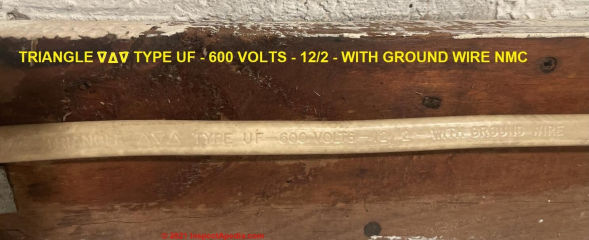
The Logo and name are actually pictured in the above photo, albeit upside down. [Corrected in the photo shown here - Ed.]
It has a three triangle logo and states Triangle Type UF 600V 12/2 WITH GROUND
On 2021-08-04 by inspectapedia.com.moderator (mod)
@MB,
That NMC (Plastic jacketed electrical wire) embossed text shows "Type UF with Ground" - a wire rated to be buried underground;
Can you find another section that shows the manufacturer's name or logo?
On 2021-08-04 by MB
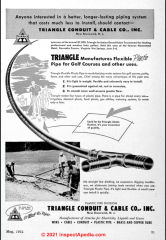 @inspectapedia.com.moderator,
@inspectapedia.com.moderator,
Thank you. Here is a picture of the outer jacket. Not much info on the web. [ photo above - Ed.]
I held a flame to it and while it did seem to shrink somewhat like plastic shoelace would, it did not seem to ignite burn itself.
[Click to enlarge any image]
On 2021-08-02 by inspectapedia.com.moderator (mod) - history of Triangle Cable & Conduit Co., aka Triangle Conduit Co., Inc. aka Triangle Wire & Cable Co.,
@MB, more on the history of Triangle Cable & Conduit Co., aka Triangle Conduit Co., Inc. aka Triangle Wire & Cable Co.,
Era: 1900s,
Location: Brooklyn, New York, United States, later Brunswick New Jersey, USA
Products: electric wires, cables and conduits ; Tricord "Rubber Armor" cords and cables
Notes:
1940, July 1, - incorporated
1948: responding to a Cease and Desist Order, 168 F.2d 175 (1948)
T
RIANGLE CONDUIT & CABLE CO., Inc., et al. - v. - FEDERAL TRADE COMMISSION. Nos. 8639, 8640, 8642, 8644, No. 8649. Circuit Court of Appeals, Seventh Circuit. May 12, 1948. Rehearing Denied June 14, 1948.
1954 Ad in Golfdom Magazine - shown below
1964, August 13, 1964, New York Times, Page 45 - bought Eagle Copper Products Co.,
1967, September 23, - bought Rowe Manufacturing div. of Canteen Corp., (Jukeboxes, vending machines etc); at this time Triangle, producing tubing, pipe, & wire products, had twelve manufacturing plants in seven U.S. States. - Coin Machine News, 23 Sept. 1967 p. 73
1985 Bought National Can Co
1991 American Metal Moulding Co., Edison, N.J., acquired by Triangle
Royal Electric, Pawtucket, R.I., acquired by Triangle in 1991.
Westwire Co., Phoenix, Ariz., acquired by Triangle in 1991.
1996, Acquired by Essex International, Triangle Wire and Cable, at the time HQ IN West Nyack, N.Y.
2014, 23 December "Former Triangle Wire workers fight to retain pensions", Adam Benson, Norwich Bulletin, Adam Benson / abenson@norwichbulletin.com / (860) 908-7004 Posted Dec 23, 2014 at 10:21 PM
On 2021-08-02 2
by inspectapedia.com.moderator (mod) - NM cable made by Triangle Wire & Cable Co Type UF with ground rated 600V.
 @MB,
@MB,
Thanks for the question and great photo; at least by eye, from the photo, that sure looks like a fiberglass or other synthetic fiber cable wrapping;
I'm researching further to see what we can find on the history of Triangle Wire & Cable Co. beyond what is discussed here.
On 2021-08-02 by MB
Found what appears to be woven asbestos or fiberglass sheath inside “modern” looking white thermoplastic NM cable made by Triangle Wire & Cable Co Type UF with ground rated 600V.
The cable is 12-2 and white with the writing debossed into the plastic without ink.
The house dates to 50s but had work done in the 60-80s.
The wire appears late 60s at earliest 80s at latest. I have found no information on this from
The web—was asbestos inner sheathing used in any NM cable in the 60s/70s?
[Photo above - Ed.]
Cloth & Varnished-Cloth Insulated Electrical Wiring Conductors
[Click to enlarge any image]
Cloth, fabric insulated wire may also be labeled "plastic" wire and will contain conductors whose individual insulation may be made of rubber, asbestos-containing rubber, or plastic (in later wires).
Above and just below: varnished-cloth electrical wire on the ballast used in a fluorescent light fixture in a 1960's home built in northern Minnesota.
Watch out: by visual inspection I don't think we can distinguish cloth, non-asbestos wiring insulation of this age from Type AVB, A plain [flame?] -retardant cotton braid: an insulation consisting of varnished cloth and impregnated asbestos. Asbestos-impregnated type AVB cloth wiring insulation is discussed separately
at ASBESTOS ELECTRICAL WIRE INSULATION.
However as you see in my photo below, this old cloth-covered electrical wire is charred in two places, making me think it may not contain asbestos. However no tests were performed.
Fragile Fabric-Covered Electrical Wire Safety Concerns
Watch out: Damaged electrical wire of any type - fabric or plastic or armored cable - can be unsafe, risking fire or shock. But don't condemn all fabric-sheathed wire out of hand. It is the condition of the wire, the correctness of its installation and the correctness of its over-current protection (fusing) that are the principal concerns.
Above: cracked, damaged insulation on electrical wire is no longer reliable and is unsafe.
According to our reader who offered the original cracked-insulation wire photo, this particular wire, dating from the 1950's, had already been removed from a building. Such wiring, if in-use, should be replaced.
Below we illustrate the fragile properties of older fabric covered wire insulation .
Inside this silver painted fabric-jacketed electrical wire you can see that the individual conductors were insulated in by a plastic coating.
Watch out: as our photos illustrate, the insulation on older fabric or rubber insulated wires may be fragile.
In stripping wires for splicing or connection you may get into a messy too-short wire problem if you don't work carefully. Worse, deteriorated insulation on electrical wires may indicate a history of overheating and such circuits may be unsafe.
Above and below I'm stripping an older type of black-colored fabric-insulated electrical cable in a Haddonfield New Jersey home.
You can see that inside the wire jacket these conductors were insulated by rubber.
This illustration of frayed fabric-insulated electrical wire powering the ceiling light shown below were provided by and used with permission of Roger Hankey, a Minnesota home inspector.
Below:
These photographs of a variety of fabric-covered rubber & plastic-insulated conductor electrical wire including copper and tinned copper from the 1950's were provided to us by a reader who planned to salvage this old copper wiring to sell for scrap. - D.D. 2016/09/12
The conductors are themselves covered by a variety of materials: fabric over rubber, rubber, and plastic. We discussed the risk that some of these wires may have been insulated using asbestos.
OPINION: There was asbestos used in wiring as fabric sheathing and possible also mixed in with rubber insulation, as we have seen by researching some early wiring patents.
In rubber you're not dealing with very friable material; if the wiring came from a movie theater or stage I'd be on higher alert. In any event taking some precautions not to make nor breathe a dusty mess would be smart, asbestos or no.
If you were facing a big cost in any regard it'd be worth having a representative sample tested by a certified lab
See ASBESTOS TEST LABS at InspectApedia.com.
Also see ASBESTOS ELECTRICAL WIRE INSULATION.
Research on Fabric - Cloth Insulated Electrical Wire Safety & History
- Black, Robert Monro. The history of electric wires and cables. No. 4. IET, 1983.
- Brigham, Harold C. EC55-1104 REPAIR of ELECTRICAL CORDS [PDF] (1955). Historical Materials from University of Nebraska-Lincoln Extension.
3293. http://digitalcommons.unl.edu/extensionhist/3293 - Brigham, Harriet C. EC55-1103 ELECTRIC CORDS: THEIR SELECTION AND CARE (1955). . Historical Materials from University of NebraskaLincoln Extension. 3294. http://digitalcommons.unl.edu/extensionhist/3294
- Ferris, R. E., and G. L. Moses. "Fibrous glass for electrical insulation." Electrical Engineering 57, no. 12 (1938): 480-483.
- Garton, C. G. THE USE OF MATERIALS AS ELECTRICAL INSULATION [PDF] Physics Education 3, no. 2 (1968): 85.
Physics Education The use of materials as electrical insulation C G Garton1 Published under licence by IOP Publishing Ltd Physics Education, Volume 3, Number 2 Citation C G Garton 1968 Phys. Educ. 3 85
Abstract
The article describes those properties of materials which are relevant to their use as electrical insulation. It is emphasized that the mechanical, thermal, chemical and electrochemical requirements are more difficult to meet in this connection than the purely electrical ones.
The physical and chemical mechanisms of failure in insulation are described, in particular the intrinsic and non-intrinsic electric strengths, the effects of discharges, thermal instability, tracking and electrochemical changes.
The main types of insulation are classified in relation to the equipment for which they are appropriate, and some indication is given of their thermal and electrical limitations. Consideration of materials used primarily as dielectrics for capacitors is excluded.
Note: See Table 1, Some Main Thpes of Equipment and the insulating systems used, p. 86 - Gilmore, Andrea M. "Preserving historic electric lighting and wiring at the frederick law olmsted national historic site." Bulletin of the Association for Preservation Technology 16, no. 3/4 (1984): 31-38.
- Goba, F. August. "Bibliography on thermal aging of electrical insulation." IEEE Transactions on Electrical Insulation 2 (1969): 31-58.
Abstract:
This collection of references on "Thermal Aging of Electrical Insulation" includes those in books, technical standards and guides, and individual articles in periodicals during the time period 1897 to 1968.
Most of the sources are from the U.S.A. and Canada; many from Europe, and some from Japan. This bibliography was prepared by the author for his own company's use initially. It has now been made available to the Electrical Insulation Group. - Greenfield, E. W. "Insulated wire and cable a typical electrical insulation system." In 1968 8th Electrical Insulation Conference, pp. 70-74. IEEE, 1968.
- Martin, R. I. COTTON TEXTILES FOR ELECTRICAL INSULATION [PDF - page 1] Journal of the Textile Institute Proceedings 22, no. 11 (1931): P165-P180.
- Meyer, L. E., Amanda M. Taylor, and J. A. York. ELECTRICAL INSULATION FIRE CHARACTERISTICS. VOLUME I. FLAMMABILITY TESTS [PDF] (1978) Boeing Commercial Airplane Co Seattle WA, 1978.
Abstract:
The results of work conducted under DOTTSC contract 1221 are presented. Standard flammability, smoke emission, and circuit integrity tests were developed for electrical wire and cable insulating materials used in rapid transit system vehicles and wayside installations.
Wire and cable insulating materials presently in use on rapid transit systems and newer polymeric materials proposed for such systems were tested and ranked with respect to their performance during the tests.
Also presented is a discussion of the need for such standard tests, the criteria for the selection of a test method, the development of the test details, and a description of the standard tests. - Osepchuk, John M. "0.4 mm Manufacturer Price Thermal Insulation Fire Resistant Silicone Rubber Coated Fiberglass Fabrics Cloth." (1980).
- Prusaczyk, J. E., and R. M. Boardway. "The effect of thermal insulation on the fire hazards of electrical wiring." Fire Technology 18, no. 2 (1982): 162-173.
Abstract:
From limited laboratory experiments performed by both the NBS and CPSC on the effects of thermal insulation on residential electrical systems, they have hypothesized that thermal insulation can change an existing electrical deficiency into a fire hazard. - Steorts, Nancy Harvey. CONSUMER PRODUCT SAFETY: A PUBLIC POLICY ISSUE [PDF] (1985).
Excerpts:
The Consumer Product Safety Commission was created by the Consumer Product Safety Act of 1972 "to protect the public against unreasonable risks of injury associated with consumer products." Capturing the spirit of the consumer movement of the 1970s, the broadly worded mandate gave the five-member commission considerable latitude in setting priorities and methods of regulation.
Since the beginning, the Commission has actively used its authority to set safety standards, ban and recall products deemed to be risky, and monitor performance of both old and new consumer goods. The sweep of the CPSC's oversight is broad, ranging from toys, cribs and sleepwear to swimming pools, lawn mowers, safety matches, electrical wire and insulation materials. In 1980, the CPSC initiated 132 recall actions against 23 million products.
As might be expected, given the form and level of its activity, the agency became heavily criticized for its many interventions in the market. As regulatory reform emerged in the early 1980s, the CPSC faced an uncertain future. - Sveriges. STANDARDIZATION OF INSULATED WIRES AND
CABLES [PDF] AIEE Journal, Institutre & Related Activities, (March 1921)
Excerpt:
A conference on the standardization of insulated wires and cables was held in New York, February 2d. The conference which was called b y the American Engineering Standards Committee at the instance of the American Railway Engineering Association, was attended by representatives of fourteen national organizations.
After a thorough discussion of the many considerations involved, it was unanimously decided that, ''The unification of specifications for wires and cables for other than telephone and telegraph use should be undertaken under one general plan, covering substantially all the more important uses." It was agreed that work on the following should be included:
Conductor, quality, stranding, sizes.
Rubber insulation.
Varnished cloth insulation.
Impregnated paper insulation.
Magnet wire (including enamel, cotton and silk insulation).
Fibrous coverings (including asbestos).
Sheaths. Armor.
Standard make-ups. - Titow, W. V. "Applications of PVC." In PVC Technology, pp. 1103-1126. Springer, Dordrecht, 1984.
- Wojtecki, Rudy G. "New developments in the insulating of electrical conductors by tape wrapping." In 1983 EIC 6th Electrical/Electronical Insulation Conference, pp. 131-135. IEEE, 1983.
- Wood, E. B., and D. R. Brobst. "Cellulose acetate treatment for textile insulation—Engineering development." The Bell System Technical Journal 11, no. 2 (1932): 213-230.
Abstract:
The development of a cellulose acetate lacquer treatment for textile insulated wire has made available an improved type of wire for telephone central office use. The desired improvement in electrical characteristics is obtained when the textile fibers are laid down and covered by the cellulose acetate film. The accompanying graphs show the comparative electrical characteristics at various humidities, of wires insulated with commercial and purified cotton and silk servings, before and after treatment with cellulose acetate lacquer.
Unidentified Fabric-Sheathed Wire: Copper with Aluminum Ground
These photographs of fabric and paper-sheathed 14/2 w/g copper wire include what appears to be a solid aluminum grounding conductor, provided courtesy of a New York electrician, via Jess Aronstein.
From its physical appearance and choice of materials we think that this wire, made in the U.S. is probably a post-war product from the late 1940s or early 1950s.
Economic studies reported in the 1980s suggested that aluminum grounding could result in savings of about 30% with respect to copper. (de Araujo 1988)
The question of electrical safety or electrical code comment on the use of mixed copper current-carrying electrical wires with an aluminum grounding conductor has not been addressed - we are researching this question. - Ed.
In our subjective analysis performed simply by exposing and bending the silver colored grounding conductor it bends more-easily than steel but was notably more bend-resistant than later aluminum wire products in which all three wires, the conductors and the ground were aluminum.
Watch out: see details about aluminum grounding conductors, including this wire, again,
Antique Fabric-Insulated Electrical Wire Research, History, Safety
- Bazerman, Charles. The languages of Edison's light. Cambridge, MA: MIT press, 1999.
- Dini, David A. RESIDENTIAL ELECTRICAL SYSTEM AGING RESEARCH PROJECT [PDF] Fire Protection Research Foundation, Quincy, MA (2008). Retrieved 6/6/2010, original source: http://ul.com/global/documents/corporate/aboutul/publications/newsletters/thecodeauthority/tca_issue_2_2008.pdf
and
The Residential Electrical System Aging Research Project done for NFPA/FPRF is available in its entirety at this site, http://ewh.ieee.org/cmte/pses/ffat/support/RESAReport.pdf - Dini, David A., P.E., SOME HISTORY OF RESIDENTIAL WIRING PRACTICES IN THE U.S. [PDF] Underwriters Laboratories, Inc., (2006)
- Dini, David A., Thomas Z. Fabian, and J. Thomas Chapin. AN ANALYTICAL STUDY OF SOME PHYSICAL PROPERTIES OF WIRE AND CABLE SAMPLES COLLECTED FROM OLDER HOMES [PDF] Underwriters Laboratories Inc (2006). David Dini, Northbrook, Ill. Tel: 1.847.664.2982;
Email: David.A.Dini@us.ul.com
These two papers were presented at the FPRF Aged Electrical Systems Symposium of 2006. These papers on this subject can be also downloaded for free at
http://www.nfpa.org/research/fire-protection-research-foundation/projects-reports-and-proceedings/proceedings/2006-proceedings/aged-electrical-systems-symposium - Edison, T.A., The DANGERS of ELECTRIC LIGHTING [PDF](1889) The North American Review, 149(396), pp.625-634.1889 RE-published by the University of Northern Iowa, http://www.jstor.org/stable/25101896 and available on JSTOR.
- Edison, Thomas A. "Manufacture of filaments for incandescent electric lamps." U.S. Patent 470,925, issued March 15, 1892.
- Edison, Thomas A. "Electric conductor." U.S. Patent 470,924, issued March 15, 1892.
- Edison, Thomas A. "Electrical Indicator" U.S. Patent 307,031, issued October 21, 1884.
- Edison, Thomas Alva. "Electric lamp." U.S. Patent 223,898, issued January 27, 1880.
- Hughes, Thomas Parke. "British electrical industry lag: 1882-1888." Technology and Culture 3, no. 1 (1962): 27-44.
- Nexans WIRE & CABLE PRODUCT GUIDE [PDF] Nexans Canada, 140 Allstate Parkway, Markham, Ontario Canada L3R 0Z7, TRel: 905-944-4300
Headquarters: Nexans, 4, allée de l’Arche, 92400 Courbevoie, France Phone : + 33 (0)1 78 15 00 00 Nexans Group was incorporated in 1994 but the company has a history of more than 100 years of operation.
...
Reader Comments, Questions & Answers About The Article Above
Below you will find questions and answers previously posted on this page at its page bottom reader comment box.
Reader Q&A - also see RECOMMENDED ARTICLES & FAQs
On 2022-07-17 by InspectApedia-911 (mod) - brownish paper is almost certainly paper
@Trey,
Brownish paper is almost certainly paper.
There were some rubber insulating products that contained asbestos, though it's not likely to be friable and should be OK if left buried.
It would help us research this question further if you could post a sharp photo of your old phone cable showing its constituents and condition,
and also if you'd mention the location of the building and the building age where this old phone cable is buried.
If you plan to strip the material and can't do so without creating a dusty mess (likely to be the case) AND if the amount you'd receive is greater than the cost of having the material tested for asbestos (about $100.) then I'd have it tested first.
Let us know what you find or decide.
On 2022-07-17 by Trey
I had an OLD phone cable (Direct Burial with Rubber outside) buried in my driveway, that kept surfacing when I'd cover it with gravel. I tested it, called miss utility, and it's no longer in use.
I CUT IT OPEN, and it had brownish, paper around the phone wires, and neoprine rubber outside. Did this type of cable contain ASBESTOS? I wanted to strip it, and sell the #2 copper, but NOT at the risk of dying.
On 2022-06-25 by InspectApedia (Editor) - Cirtex wiring
@Mike 412,
I'll research the question further.
Given that wires would not normally showed a meaningful amount of any particle in a building except in very unusual conditions can you elaborate a bit on your asbestos concern?
Also be sure to take a look at
ASBESTOS ELECTRICAL INSULATION
For clarity, you typed "Citrex" electrical wire but I think you meant to ask about "Cirtex" - listed and described in detail above on this page.
Cirtex and Cirtek were a brand of fabric-covered electrical wire.
Citrex or more-accurately, Citrix Systems, is a contemporary "technology systems" company as they describe themselves, in the business of computer-related products and services, staffed in part by ex IBM'ers (which I am, too). The company says
"Citrix was originally named Citrus but changed its name after an existing company claimed trademark rights. The Citrix name is a portmanteau of Citrus and UNIX."
You'll see in our information on Cirtex that the company listed a number of "fire resistant" products so within its product line there may have indeed been some asbestos-containing products.
In my OPINION only if you are faced with an unusual situation, perhaps having to demolish old wiring in such a way that it will be damaged, producing dust and debris, would it be justified to test the wire insulation for asbestos.
in its normal installation electrical wiring is mostly run in building cavities, not exposed to damage, and even where exposed, if installed as per the electrical codes, is not placed where it's subject to abrasion or other damage.
On 2022-06-25 by Mike 412
I have not been able to find any further information about the circle cable and wire company and the Citrex brand that you have a photo of below. I am trying to determine if this wire insulation contains asbestos.
On 2021-11-17 by Inspectapedia Com Moderator
@Amanda,
It's very common in the old electrical wiring to find fabric insulated wire.
The color conventions are still used today so red or red and black would be a hot wire
On 2021-11-17 by Amanda
Hello! I've been reading and I seem to have .any generations of wiring. I believe house was built 1930. I cant seem to identify these? light fixture, one wire has a black line running along it, other has red hash marks. thank you!
On 2021-10-27 by inspectapedia.com.moderator - Colonial Flex wiring
@Logan,
Agreed.
Take a look at
ASBESTOS WIRE INSULATION IDENTIFICATION
On 2021-10-27 by Logan
My ~1960 ranch is wired with "Colonial Flex". Seems like a fiberglass or hopefully not asbestos over plastic covered copper, with a half sized ground.
On 2022-08-16 by InspectApedia-911 (mod) - Not all fabric insulated (cloth sheathed) wire is unsafe
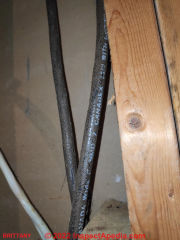 @Brittany,
@Brittany,
Thank you for the photos and question about Canadex electrical wire.
Above on this page under the Loomex entry you'll see that we describe this product and we've added your Canadex photo under our CANADEX entry.
**IF** your question is about asbestos electrical wire insulation: some versions of CANADEX wire were described as flame resistant - most-often used in high-risk installations such as theatres and hospitals.
So in the absence of clear details from the company we don't rule out that the wire may contain asbestos - which MIGHT have been what you are asking about.
IF you're simply asking if fabric-insulated electrical wire is problematic, my answer is no. It's the condition of the wire and the correctness of wiring installation that are key in assessing the wiring system safety. Your home inspector should point out any mis-wiring, amateur wiring, signs of overheating, or unsafe electrical details.
IF your inspector saw evidence that your cloth-insulated wire was in poor condition: fraying, damaged, etc. that's worth noting and correcting. Usually it's overheating that is the cause of damage to electrical wire insulation.
You may read some web articles and OPINIONS that "cloth or fabric-insulated electrical wire is outdated and unsafe" but in our opinion, while a warning to inspect the condition of the electrical system and its wiring is entirely correct, it's a bit of an over-reach to condemn such wiring out of hand.
Overall one would not refuse to buy a building that uses fabric-insulated electrical wire, per se but naturally the condition of the wiring is an important safety observation.
As an example of why condemning all fabric-sheathed electrical wire can be over-reaching, cloth- or fabric-insulated electrical wiring is still sold (in 2022), such as by Sundial who sell fabric insulated wire often used in suspended lighting applications and cord sets.
If you have other concerns do let me know.
Watch out: it is not quite safe to leave electrical wires simply snipped off and floating in an electrical box as shown in your second photo - shown below.
It'd be safer to put a twist-on connector on the ends of the hot wires (usually red and black) and the white wire (usually neutral).
On 2022-08-15 y Brittany
Follow up to below, here's another photo
Hello. I have found this in a home in interested in buying. It was built in the 90's but it was strange to find cloth covered wire with this type on paper and insulation.
See photo. I believe it is Canadex NMD-7 which now operates as Nexans.
I've reached out to the company as well but realistically don't expect any response. Hope someone can help here :) Thanks.
[Photo above at Moderator's reply]
On 2022-07-17 by InspectApedia-911 (mod)
@Trey,
Brownish paper is almost-certainly paper.
There were some rubber insulating products that contained asbestos, though it's not likely to be friable and should be OK if left buried.
It would help us research this question further if you could post a sharp photo of your old phone cable showing its constituents and condition,
and also if you'd mention the location of the building and the building age where this old phone cable is buried.
If you plan to strip the material and can't do so without creating a dusty mess (likely to be the case) AND if the amount you'd receive is greater than the cost of having the material tested for asbestos (about $100.) then I'd have it tested first.
Let us know what you find or decide.
On 2022-07-17 by Trey
I had an OLD phone cable (Direct Burial with Rubber outside) buried in my driveway, that kept surfacing when I'd cover it with gravel. I tested it, called miss utility, and it's no longer in use.
I CUT IT OPEN, and it had brownish, paper around the phone wires, and neoprine rubber outside.
Did this type of cable contain ASBESTOS? I wanted to strip it, and sell the #2 copper, but NOT at the risk of dying :)
On 2022-06-25 by InspectApedia (Editor) (mod) - Cirtex fire-resistant wiring products (not "Citrex")
@Mike 412,
You'll see in our information on Cirtex that the company listed a number of "fire resistant" products so within its product line there may have indeed been some asbestos-containing products.
In my OPINION only if you are faced with an unusual situation, perhaps having to demolish old wiring in such a way that it will be damaged, producing dust and debris, would it be justified to test the wire insulation for asbestos.
in its normal installation electrical wiring is mostly run in building cavities, not exposed to damage, and even where exposed, if installed as per the electrical codes, is not placed where it's subject to abrasion or other damage.
On 2022-06-25 by InspectApedia (Editor) (mod)
@Mike 412,
I'll research the question further.
Given that wires would not normally showed a meaningful amount of any particle in a building except in very unusual conditions can you elaborate a bit on your asbestos concern?
Also be sure to take a look at
ASBESTOS ELECTRICAL INSULATION inspectapedia.com/hazmat/Asbestos_Electrical_Insulation.php
Continuing:
For clarity, you typed "Citrex" electrical wire but I think you meant to ask about "Cirtex" - listed and described in detail above on this page.
Cirtex and Cirtek were a brand of fabric-covered electrical wire.
Citrex or more-accurately, Citrix Systems, is a contemporary "technology systems" company as they describe themselves, in the business of computer-related products and services, staffed in part by ex IBM'ers (which I am, too). The company says
"Citrix was originally named Citrus but changed its name after an existing company claimed trademark rights.
The Citrix name is a portmanteau of Citrus and UNIX."
On 2022-06-25 by Mike 412
I have not been able to find any further information about the circle cable and wire company and the Citrex brand that you have a photo of below. I am trying to determine if this wire insulation contains asbestos.
On 2022-06-06 by InspectApedia-911 (mod)
@Anonymous,
Sorry I don't understand the question
On 2022-06-06 by Anonymous
I ?despite the homes have asbestos
At least why I have asbestos question mark
On 2021-11-17 by Inspectapedia Com Moderator (mod)
@Amanda,
It's very common in the old electrical wiring to find fabric insulated wire.
The color conventions are still used today so red or red and black would be a hot wire
On 2021-11-17 by Amanda
Hello! I've been reading and I seem to have .any generations of wiring. I believe house was built 1930. I cant seem to identify these? light fixture, one wire has a black line running along it, other has red hash marks. thank you!
On 2021-10-27 by inspectapedia.com.moderator (mod) - Colonial Flex Type NM 12/2 with ground Fabric Insulated Wire
@Logan,
Agreed.
Wiring that used asbestos for flame or heat resistance is most-likely to be found in special applications such as theatre wiring and inside some heating type appliances or stovetops.
Take a look at
ASBESTOS WIRE INSULATION IDENTIFICATION
https://inspectapedia.com/electric/Old_Electrical_Wiring.php#Asbestos_Wire
On 2021-10-27 by Logan
My ~1960 ranch is wired with "Colonial Flex". Seems like a fiberglass or hopefully not asbestos over plastic covered copper, with a half sized ground.
On 2021-05-03 by (mod)
@Andrew m,
Thank you for the damaged insulation on knob and tube electrical wiring report. It's an important condition for other readers to note. I expect that with the insulation is damaged or lost on older electrical wire is either because the wire was previously overheated which means it wasn't properly fused or there have been unusual environmental conditions such as water damage.
I also have occasionally found rodent damage at which wires have been not fair but that's usually much more localized.
It would be helpful if you can post photos, one per comment, of what you found.
On 2021-05-02 by Andrew m
Opened a wall had knob and tube bare wire with pieces of fabric insulation from one end of the wall to the other
On 2021-04-24 by (mod)
@Niqi,
Sorry, but no one can know which wires are hot, neutral, ground - for sure - from a photo.
Normally black (or blue or red would be hot and white neutral, and often a pair of wires interrupts the hot to run power through a switch for controlling a light.

But the only safe thing to do is use a DMM or VOM to actually test each wire to be sure it's correctly used.
From the ARTICLE INDEX this may be of use: DMMs VOMs SAFE USE OF inspectapedia.com/electric/DMM_VOM_Safety.php
and
DMM DIGITAL MULTIMETER HOW TO USE inspectapedia.com/electric/DMM_How_to_Use.php
Watch out: in your photo I see that at least one wire, a red one, looks overheated, burned, and with a bare end exposed: there are fire and shock hazards here.
Keep in mind that if you're not familiar with safe electrical wiring you could be shocked or killed.
On 2021-04-24 by Niqi
Help identify wiring please. Found like this.
On 2021-03-11 by (mod) - Clifton-conduit-E-7032-Type-NM-12/2 electrical wire: aluminum wiring hazard warnings
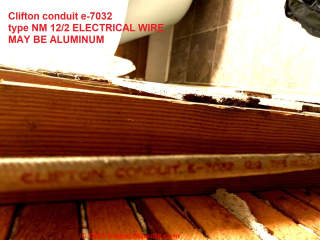 @Anonymous,
@Anonymous,
Watch out: Aluminum wire may have been added for more than 1 circuit, and may not be so labeled. Often the use of #12 wire on what's usually a 15 amp circuit is a Clue.
See
ALUMINUM WIRING IDENTIFICATION
On 2021-03-11 by Anonymous
thank you, the home was built in 1925 and in the Portland Oregon area. There are a lot of different types of wiring. Before I moved in the seller did some repairs to the wiring and I had it reinspected.
It was deemed safe, based on what they could see. My house was previous a rental for many years and it is becoming apparent it was subject to many haphazard and cheap repairs.
The wire does not have AL or CU or anything else I can find indicating material on it. The switch does not appear to be connected to anything else so I don’t know if it was for a light, fan or heater that has since been removed. The box for the switch is also packed with what looks like fiberglass insulation, which I have never seen before.
On 2021-03-10 2 - by (mod) -
@Amanda, be sure to see the articles I recommended. The safety concern could involve many more connections than this one switch.
Where is the home and what is it's age?
On 2021-03-10 by Amanda
thank you the wire is hot and goes to a switch that is not connected to anything else. i was considering using it to put an additional outlet but it sounds like I need to have an electrician look at it. I could not find any info on this specific brand of wiring. If anyone else is familiar with it please let me know.
On 2021-03-10 - by (mod) -
@Amanda,
Electrical wire doesn't wear out with age, though it can be damaged by overheating or mechanical injury.
But the fact that it's 12/2 rather than 14/2 suggests that it may be aluminum electrical wiring - a fire hazard unless it has been properly repaired at every connection where that wire is present.
See details at
ALUMINUM WIRING IDENTIFICATION https://inspectapedia.com/aluminum/Aluminum_Wire_Identification.php
and at
ALUMINUM WIRING REPAIR METHODS https://inspectapedia.com/aluminum/Aluminum_Wiring_Repair_Methods.php
On 2021-03-10 by Amanda
Can you tell me about this wire I exposed while remodeling my bathroom. If it is not clear in the picture it says “Clifton conduit e-7032 type NM 12/2. How old is this wire?
Is it safe to keep or should it be replaced?
[Photo shown above - Ed.]
On 2021-03-06 - by (mod) -
@Doug,
Thank you for your opinion on the durability of cloth- or fabric-covered wire in [where are you?] some locations.
If you have photos of the damage you discuss those would be valuable to add - you can post one photo per comment.
If you have research on this question that would be valuable as well; I tried researching the question of "durability of fabric- insulated electrical wire" without finding expert research focused on that topic in comparison with plastic NMC or metal BX type wire.
Let's "fight for the truth" as you so aptly put it, by seeing if we can find some expert research on the topic.
On 2021-03-06 by Doug
Cloth wire causing so much trouble in the older home sales. There IS an abundance of THERMAL PLASTIC INSULATED COPPER WIRES WITH A BRAIDED OUTER JACKED IN THE OLD HOMES I INSPECT. What material are you actually finding where you can see the actual wires where exposed as in a receptacle of breaker panel??? Because here in Florida, I am finding the thermal plastic insulated copper wires in homes up to 65 yrs of age
I believe the nickname for TRULY CLOTH INSULATED COPPER OR NICKEL PLATED CONDUCTOR / WIRE IS 'RAG WIRE" which I agree is unsafe.
I have done my own electrical work since 1973, BOTH LARGE DC VOLTAGE SYSTEMS IN TELEPHONY WORK & HAVE COMPLETELY RE-WIRED A HOME I BOUGHT INCLUDING CUTTING & SPLICING THE HOT SERVICE CABLES & worked on electronics since 10 yrs of age
I LIKE TO FIGHT FOR THE TRUTH even though in the long run, I am wrong to do so as the institutions eventually win even the most Ludacris arguments due to there power to convince people (and home inspectors. So, am I wrong or right.
On 2020-07-29 by Chris - Type RW Versatol Branded fabric-insulated electrical wire
Can anyone put a date to these cables using 600 volt? I'm trying to determine age and if they contain asbestos, thanks
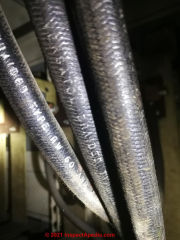
On 2020-07-06 - by (mod) -
George, some photos would be helpful, 1 per comment.
On 2020-07-05 by George
I unearthed underground armored cable probably dating from 1905 or 1906. The armor was rusted out. It had two copper wires each with black fabric or cloth insulation, the pair covered in what looked like white plastic and on top of that a LEAD jacket and all that with the standard flexible, ribbed iron armor.
On 2020-06-04 - by (mod) -
Andrew
See my notes on my copy of your photo;
On 2020-06-04 by Andrew
Any ideas on what the heck I'm seeing here?
On 2020-05-08 - by (mod) -
Its the condition of the wiring as well as the other components of the electrical system that is most important.
On 2020-05-07 by Gerald Arnett
Is old fabric wire insulated wire in a home dangerous and is it a problem with insurance
On 2020-02-28 - by (mod) -
Cond.
Regarding the question of determining the ampacity rating of non-metallic cable from the exterior when you can't read the markings
There are some general measurements for the outer diameter of electrical cables of various and ampacity or wire conductor sizes, but I don't think that that would be reliable for the case that you described.
We're left with finding an exposed wire conductor end and thus with making a direct examination of the copper diameter.
On 2020-02-28 5 by Conductor wire size on old wiring
I have a home built in the mid-west, circa 1960. The wiring has two conductors plus ground with fabric covering the outside and plastic insulation on the inside copper conductor. The outside fabric insulation is white with green lettering. I am unable to read the green lettering since it is all faded.
Is there a way to determine the conductor wire size from the outside of the wire?
Thanks for everyone's help.
On 2019-03-03 by (mod) - Should the Southwire NM product shown typically suspected of being ACM?
AJApologies for not simply being comfortable saying "yes" or "no" when the truth is I can't be sure. Clearly the same wire products with same names were manufactured over many years and components may have varied.
Some Southwire patents cite use of asbestos.
Everything I can tell you about the risk of asbestos in electrical wire is at the article I suggested
ASBESTOS ELECTRICAL INSULATION inspectapedia.com/hazmat/Asbestos_Electrical_Insulation.php
On 2019-03-03 by AJ
Should the Southwire NM product shown typically suspected of being ACM? The conductors are coated in plastic with a paper between all wrapped in the fabric.
On 2019-03-03 by (mod) -
AJ
Thank you for asking for an important clarification.
The article on this page is about electrical wire brand identification and is not focused on the use of asbestos in electrical wire- a topic we deal with in a separate exposition.
In our separate article (found by searching InspectApedia.com for "asbestos electrical wire"
ASBESTOS ELECTRICAL INSULATION inspectapedia.com/hazmat/Asbestos_Electrical_Insulation.php
We refer to wire insulation that can be either or both the external jacket covering the entire wire assembly or the insulation on individual conductors
For example inside appliances such as stove tops, ovens, irons, toasters, individual conductors sometimes used asbestos fabric, while in theatre wiring such as shown in that separate article
the external jacket of the wire used asbestos cloth and sometimes a wire loom.
THanks for asking
On 2019-03-03 by AJ
What research can you find on Southwire brand cloth-covered NMC? Does it contain asbestos?
I do find this article alittle unspecific. Is the concern with residential cloth wire containing asbestos particular to the jacket (usually split and shredded when making a splice) or the conductors’ insulation?
IMAGE LOST by older version of Comments code - now fixed. Please re-post the image if you can. Sorry. Mod.
On 2019-02-02 by (mod) -
Apologies NGBut from your photo alone, no scale, no other information, I can't tell for sure what I"m looking at: thermostat wire or 120/240VAC wire or something else.
I can see that the wire was run through wood with no strain relief nor sealant. It might also not be rated for outdoor use or sunlight exposure.
Perhaps you can tell us more:
The country and city of the building where the wire is in use
If you know if it's 120VAC or something else
The building age and if known , the wire age and what it's powering or controlling
Closeup photos of any markings, embossing, stamps, or text along the wire ( almost always present)
On 2019-02-02 by N. Giroux
Hello,
I would like to know what kind of cable appears in the attached image and if possible when this kind of cable has been used and if the production of that kind of cable has been stopped and when if it's the case ?
Thank you !
N. Giroux
IMAGE LOST by older version of Comments code - now fixed. Please re-post the image if you can. Sorry. Mod.
...
Continue reading at OLD ELECTRICAL WIRING TYPES or select a topic from the closely-related articles below, or see the complete ARTICLE INDEX.
Or see these
Recommended Articles
- ALUMINUM WIRING IDENTIFICATION
- ASBESTOS ELECTRICAL WIRE INSULATION
- ELECTRICAL COMPONENTS, AGE, TYPES
- ELECTRICAL PANEL AGE - panel age can help determine the age of a building's electrical wire & other components
- ELECTRICAL WIRE TYPES CODES USES - current electrical wire identification markings
- KNOB & TUBE WIRING
- OLD HOUSE ELECTRICAL SYSTEMS - home
- OLD ELECTRICAL WIRING TYPES - timeline of use of different types of electrical wire & wire insulation
- ALUMINUM ELECTRICAL WIRE IDENTIFICATION
- ANTIQUE & OLD ELECTRICAL RECEPTACLES
- ANTIQUE LAMPS (BULBS) & CONNECTOR TYPES
- ANTIQUE LAMPS (BULBS) LIGHT OUTPUT - LUMENS
- ARMORED CABLE or BX WIRE IDENTIFICATION
- ASBESTOS WIRE INSULATION IDENTIFICATION
- ASBESTOS ELECTRICAL WIRE INSULATION
- CLOTH WIRE INSULATION IDENTIFICATION
- CONDUIT WIRE IDENTIFICATION
- COPPER CLAD ALUMINUM WIRE IDENTIFICATION
- EXTENSION, LAMP, ZIP CORD WIRE IDENTIFICATION
- FABRIC NMC WIRE INSULATION IDENTIFICATION
- KNOB & TUBE WIRE IDENTIFICATION
- PLASTIC NMC WIRE INSULATION IDENTIFICATION
- RUBBER WIRE INSULATION IDENTIFICATION
- SOLID PIPE EDISON DC CABLE HISTORY
- THEATER WIRE IDENTIFICATION
- TINNED COPPER WIRE IDENTIFICATION
- WIRE LOOM or WIREDUCT WIRE CONDUIT
- SOLID PIPE EDISON DC CABLE HISTORY
Suggested citation for this web page
FABRIC NMC WIRE INSULATION IDENTIFICATION at InspectApedia.com - online encyclopedia of building & environmental inspection, testing, diagnosis, repair, & problem prevention advice.
Or see this
INDEX to RELATED ARTICLES: ARTICLE INDEX to ELECTRICAL INSPECTION & TESTING
Or use the SEARCH BOX found below to Ask a Question or Search InspectApedia
Ask a Question or Search InspectApedia
Try the search box just below, or if you prefer, post a question or comment in the Comments box below and we will respond promptly.
Search the InspectApedia website
Note: appearance of your Comment below may be delayed: if your comment contains an image, photograph, web link, or text that looks to the software as if it might be a web link, your posting will appear after it has been approved by a moderator. Apologies for the delay.
Only one image can be added per comment but you can post as many comments, and therefore images, as you like.
You will not receive a notification when a response to your question has been posted.
Please bookmark this page to make it easy for you to check back for our response.
IF above you see "Comment Form is loading comments..." then COMMENT BOX - countable.ca / bawkbox.com IS NOT WORKING.
In any case you are welcome to send an email directly to us at InspectApedia.com at editor@inspectApedia.com
We'll reply to you directly. Please help us help you by noting, in your email, the URL of the InspectApedia page where you wanted to comment.
Citations & References
In addition to any citations in the article above, a full list is available on request.
- Roger Hankey is principal of Hankey and Brown Inspections, Winter Park, CO. Mr. Hankey is a past chairman of the ASHI Standards Committee and served in other ASHI chapter and national leadership roles. Mr. Hankey is a National Radon Proficiency Program certified measurement professional and a Level II infrared thermographer. Contact Roger Hankey at: 970-393-6604 - rogerhankey47@gmail.com . Website: www.HankeyandBrown.com Mr. Hankey is a frequent contributor to InspectAPedia.com.
- Norwig, E. A. "Patents of Thomas A. Edison, The." J. Pat. Off. Soc'y 36 (1954): 275.
- In addition to citations & references found in this article, see the research citations given at the end of the related articles found at our suggested
CONTINUE READING or RECOMMENDED ARTICLES.
- Carson, Dunlop & Associates Ltd., 120 Carlton Street Suite 407, Toronto ON M5A 4K2. Tel: (416) 964-9415 1-800-268-7070 Email: info@carsondunlop.com. Alan Carson is a past president of ASHI, the American Society of Home Inspectors.
Thanks to Alan Carson and Bob Dunlop, for permission for InspectAPedia to use text excerpts from The HOME REFERENCE BOOK - the Encyclopedia of Homes and to use illustrations from The ILLUSTRATED HOME .
Carson Dunlop Associates provides extensive home inspection education and report writing material. In gratitude we provide links to tsome Carson Dunlop Associates products and services.



